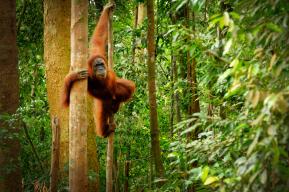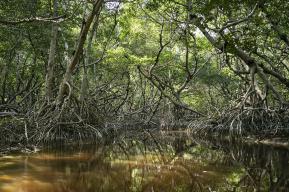مقال
ريمكو فان ميرن: "حماية الأنواع البيولوجيّة تشكو من نقص الموارد"

لئن تتعرّض بعض الأجناس، اليوم، إلى الخطر، فإنّ أجناسا أخرى تشهد تزايدا في أعدادها بفضل إجراءات الحفظ والحماية. إلاّ أنّ نجاح هذه الإجراءات يفترض توفّر مقاربة على المدى الطويل، وموارد، وإرادة سياسية، كما أوضح ذلك ريمكو فان ميرن، منسّق صندوق حفظ الأجناس التابع للاتحاد الدولي لحفظ الطبيعة UICN.
أجرت الحوار آنياس باردون
اليونسكو
ما هي الشروط الواجب توفّرها حتى تكون الجهود المبذولة في وقف تدهور أو اختفاء الأجناس المهددة بالانقراض مُثمرة؟
لا يوجد حلّ سحريّ لمنع انقراض الأجناس أو استعادتها إلى الحياة. فنجاح الإجراءات التي تم اتّخاذها مُرتبط بعددٍ من العوامل، منها بالخصوص بيولوجيا الجنس، ونوع التّهديدات التي تواجهها، والعوامل الاجتماعية، إلخ. وفي الواقع، إن تظافر إجراءات مختلفة هو الذي يصنع الفارق.
فعلى سبيل المثال، بالنسبة لمرعيّة غوام، وهي طيور مستوطنة في أوقيانوسيا، كانت، منذ سنة 1984، موضوع برنامج لتربية الحيوانات داخل فضاء مُغلق، وقد تطلّب الأمر القيام بعدّة محاولات لإعادة توطينها بهدف إنشاء مجموعات مُستقلّة في جزيرة كوكوس، على ساحل القرن الجنوبي لغوام، بالمحيط الهادئ. كما كان اعتماد إجراءات لمكافحة غزو أَفْعَى الشَجَر البُنِيَّة أمرا أساسيًا أيضًا.
ويُبيّن آخر تحديث للقائمة الحمراء النّجاحات التي تحقّقت فيما يخصّ ببّغاء موريشيوس بجزر موريشيوس، وسمك السّلمون المرقّط، وهو سمك مفترس، كبير الحجم، يعيش في المياه العذبة في نيو ساوث ويلز، في أستراليا. ويُمثّل ببّغاء موريشيوس موضوع برنامج للحفظ منذ سنة 1973. وتعود الزّيادة المذهلة في عدد هذه المجموعة خلال السّنوات الأخيرة، في جانب كبير منها، إلى رعاية مجموعة الحيوانات البريّة إضافة إلى نجاح برنامج التّربية في الفضاءات المُغلقة، الذي تمّ بعثه سنة 1993.
بالنسبة إلى سمك السّلمون المرقّط، تم وضع برنامج لإعادة تكاثره في الثمانينات ومحاولة إعادة توطين هذا الجنس في نهر أوفنس، حيث كان وفيرًا من قبل. وبداية من سنة 1997 إلى سنة 2006، أُطلقت في النهر، على نحو مسترسل، إصبعيات أو زرّيعة سمك السّلمون المرقّط التي تم تربيتها في المفرّخات. ويُرجّح أنّ نجاح هذا البرنامج يعود إلى كون الإصبعيّات، وأسماك أخرى عمرها سنة واحدة، تمّت إعادة توطينها سنويّا على مدى 10 سنوات، في حين أن البرامج القصيرة المدى في الممرّات المائية الصغيرة، كانت محدودة النّجاح.
هذه الأمثلة تُبيّن مدى الارتباط بين تحقيق نجاحات في مجال الحفظ، من جهة، واتّخاذ إجراءات على المدى الطويل والتّعاون بين مختلف الجهات الفاعلة، من جهة أخرى.
هل ينطبق الشّيء ذاته على حفظ الأجناس النباتية؟
مبدئيّا، يُفترض أنّ استرداد الأجناس النّباتية أسهل، شريطة أن تتمّ معالجة التّهديدات بشكل ملائم. فالجَمْعُ بين الحفظ داخل الموقع وخارجه غالبا ما يكون ضروريّا. رغم أنّ السنوات الأخيرة لم تُسجّل سوى نجاحات محدودة جدّا في مجال الحفاظ على النّباتات.
أما عن الجهود المبذولة لوقف تدهور الأشجار المهدّدة في غابة الأروكاريا بالبرازيل، وخاصة منها صنوبر بارانا (أراوكاريا أنجوستيفوليا)، وهو نوع يُعدّ في خطر كبير، فهي واعدة. لكن التأكّد من نجاحها يستوجب عدّة سنوات أخرى بالنّظر إلى العمر الطويل لهذه الأشجار.
ما هي أهمّ العقبات التي يجب التّغلّب عليها لحماية الأجناس المهددة؟
في البداية، كلّما تعرّض جنس ما إلى التهديد إلاّ ووجبت مجابهة هذا التّهديد. وفي صورة عدم التوفّق في القضاء عليه أو الحدّ منه على الأقلّ، فإن كلّ إجراء يتمّ القيام به من أجل تكاثر هذا الجنس ستكون حظوظ نجاحه محدودة.
إنّ إحدى أهمّ العقبات التي تقف أمام حماية الأجناس هي قلّة الموارد، سواء المالية منها أو البشريّة، إلى جانب غياب الإرادة السياسية. فعلى الصّعيد العالمي، نادرا ما تكون أهداف حفظ التنوّع البيولوجي مُدرجة في مخططات التّهيئة التّرابية، ممّا أدّى إلى تدهور موائل ذات أهمية حيوية بالنسبة للأجناس المهدّدة وتجزئتها.
هل يمكن إعادة إنتاج تلك النّجاحات الباهرة في مجال الحفظ في مجالات أخرى؟
نعم، يمكن إعادة إنتاج تلك النّجاحات كما تُبيّنه التّحديثات المتلاحقة للقائمة الحمراء التي تسلّط الضّوء على النّجاحات الباهرة في مناطق مختلفة من العالم.
بيد أن الحلّ الذي ينجح مع جنس معيّن في مكان ما لا يُؤدّي بالضّرورة إلى النّتيجة ذاتها مع نفس الجنس في مكان آخر (ناهيك عن الأجناس الأخرى)، لأنّ نجاح إجراءات الحفظ لها، أيضًا، صلة بالبيئة المحليّة، لاسيما فيما يتعلّق بالقيم الثّقافية والقواعد الاجتماعية المحليّة. هذا ما نشاهده بوضوح تامّ في حالات النّزاع بين البشر والحيوانات المحلّية على سبيل المثال؛ فالحلّ الذي قد يكون ملائما لفضّ النزاع بين الإنسان والفيل وفق سيناريو معيّن قد لا يكون ملائما في سياق مغاير.
هل للسّياحة دائما تأثير سلبي على حفظ الأجناس؟
ليس بالضّرورة. بل يمكن أن تكون إيجابية على الحفظ في بعض الحالات. فالاتّحاد الدّولي لحفظ الطبيعة يعمل مع المنتدى الاقتصادي العالمي لرصد مؤشرات استدامة الأسفار والسّياحة. وقد نشر، أيضًا، توصيات في مجال إدارة السّياحة والزائرين في المناطق المحميّة. كما يُمكن للسّياحة أن تساهم في المحافظة بفضل العائدات الاقتصادية التي تحقّقها، والتي يمكن –بل وينبغي- أن تساهم في حماية الأجناس، خاصّة عندما تعتمد السياحة على الحالة الصحّية الجيّدة للحيوانات البريّة والحالة الحسنة للموائل الطبيعية.
مطالعات ذات صلة
إصلاح الحياة البحريّة، رسالة اليونسكو، يناير- مارس 2021
في تاهيتي، التّقاليد تسارع إلى إنقاذ الطّبيعة، رسالة اليونسكو، يناير- مارس 2021
مدغشقر: توازن هشّ، رسالة اليونسكو، أكتوبر 2008
اشترك في رسالة اليونسكو لمتابعة الأحداث. الاشتراك في النسخة الرقمية مجاني %100.
Interview by Agnès Bardon
UNESCO
What are the conditions for efforts to halt the decline or disappearance of threatened species to yield positive results?
There is no silver bullet to prevent extinctions or achieve population recoveries. Successful efforts depend on a number of factors, including the biology of the species, the threats it faces, social factors, etc. In fact, it is the combination of different efforts that usually makes a difference.
For example, in the case of the Guam rail – a bird endemic to Oceania, which has been the subject of a captive-breeding programme since 1984 – several reintroduction attempts were required to enable the establishment of a self-sustaining population on Cocos Island, off the southern tip of Guam in the Pacific Ocean. The adoption of measures to control the invasion of the brown tree snake also continues to be key.
The latest update of the IUCN Red List of Threatened Species shows the success stories of the echo parakeet in Mauritius, and the trout cod (Maccullochella macquariensis), a large carnivorous fish found in the fresh waters of New South Wales, Australia. The echo parakeet has been the subject of a conservation programme since 1973. The dramatic increase in its population in recent years owes much to the intensive management of the wild population, combined with a successful captive-breeding programme launched in 1993.
In the case of the trout cod, a breeding programme was established in the 1980s in an attempt to reintroduce the species to the Ovens River, where it was once abundant. In 1997, and in every following year to 2006, juvenile hatchery-reared trout cod were released into the river. This programme may have been successful because fingerlings and one-year-olds were reintroduced annually for ten years, whereas shorter-term programmes in smaller waterways have had limited success.
These cases demonstrate that successful conservation requires long-term efforts, and collaboration between different stakeholders.
Successful conservation requires long-term efforts
Does the same apply for the conservation of plant species?
For plants, it should in general be easier to get recovery, provided that the threats are adequately addressed. A combination of in situ and ex situ conservation is often needed. However, very few plant conservation successes have been recorded in recent years. An example of a promising project is work on the restoration of threatened trees in the Araucaria forests in Brazil, including the critically endangered Paraná pine (Araucaria angustifolia). But it will take a few years to be able to measure its success, as these trees are long-lived species.
What are the main obstacles to be overcome to protect threatened species?
One of the first priorities should be to address the threats a species is facing. Unless those threats are removed, or at the very least, reduced to a manageable level, any efforts to increase species populations are likely to fail.
One of the main obstacles to the protection of species is the lack of resources, both financial and human. Another is the lack of political will. Globally, biodiversity conservation objectives are still rarely integrated into land-use planning, which leads to further degradation and fragmentation of important habitats for threatened species.
Biodiversity conservation objectives are still rarely integrated into land-use planning
Can conservation success stories be duplicated in other areas?
Yes, success stories can be duplicated elsewhere, as each Red List update demonstrates, by highlighting success stories from different parts of the world.
Having said that, a solution that works for a certain species in one location may not necessarily work for the same species in another location – let alone for another species. This is because the success of conservation efforts also depends on the local context, including local cultural values and social norms. We see this very clearly in situations of human-wildlife conflict, for example. A solution that works to address human-elephant conflict in one scenario may not be suited to another context.
Does tourism always have a negative impact on species conservation?
Not necessarily. In some cases, tourism can be positive for conservation. In fact, IUCN works with the World Economic Forum (WEF) to track travel and tourism sustainability metrics. IUCN also recently published some best practice guidelines for Tourism and visitor management in protected areas.
Tourism can contribute to conservation through the economic benefits it generates. These revenues can, and should, contribute to the protection of species – particularly where tourism depends on healthy wildlife populations and natural habitats.

In the same issue










